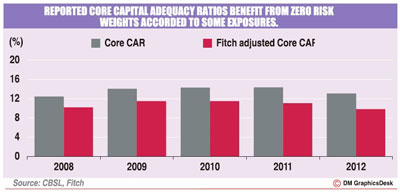Reply To:
Name - Reply Comment
 The capital adequacy of the Sri Lankan banking sector to withstand sudden solvency risks is not as healthy as reported statistics, a top Fitch Ratings official told a recent forum in Colombo.
The capital adequacy of the Sri Lankan banking sector to withstand sudden solvency risks is not as healthy as reported statistics, a top Fitch Ratings official told a recent forum in Colombo.
According to Senior Director and The Head of Financial Institutions, South and South East Asia at Fitch, Ambreesh Srivastava, there seems to be a distortion in the capital adequacy ratios in Sri Lanka because the banks do not account for their government exposure and the pawning loans which could have a lowering impact.
“As far as Sri Lanka is concerned, the reported regulatory Tier 1 Capital Adequacy Ratio (CAR) looks fine. But it would considerably lower if adjusted for zero-risk weighted assets such as government loan exposures or pawning loans for example.
 “The point taken is that some of these things are low risk. But it does distort some of the capital ratios if you were not to account for them at all,” he pointed out.
“The point taken is that some of these things are low risk. But it does distort some of the capital ratios if you were not to account for them at all,” he pointed out.
Although by end December the reported banking sector core-CAR stood at 14 percent, the Fitch adjusted core- CAR stands at just under 10 percent.
It was only few months before Mirror Business revealed the largest lender to the government, Bank of Ceylon had come under scrutiny by international rating agencies in view of weakening capital adequacy.
Meanwhile Srivastava pointed out the possibility of bankers becoming complacent going by these reported high capital adequacy ratios.
“On the face of it, capital adequacy in Sri Lanka looks high and it sometimes leads to complacency among the banks that their equity is fine and so on. But it is less so.
I don’t want to give the impression that the banks are facing solvency issues,” he added.
He further stressed on the need to find more capital given the fact that Sri Lankan banks have been operating as active intermediaries in funding the country’s growth over the last couple of years. This in fact has occurred in tandem with increasing their state exposures.
“….the banks have been the active intermediaries of funding that growth and therefore they need to find capital”.
“….given the fact that it is likely to be a high growth economy and banks will likely to be major instruments which finances this growth, at least for the foreseeable future, capital would be important (for the banks),” he remarked.
Srivastava further said that there were limitations on rating upside for most Asian banks due to rapid credit growth and ‘cheap money’ leading to asset inflation and other associated risks.